Dr. Phil Zeltzman’s Blog
What you need to know about broken bones
We repair a surprisingly large number of fractured bones (aka broken bones).
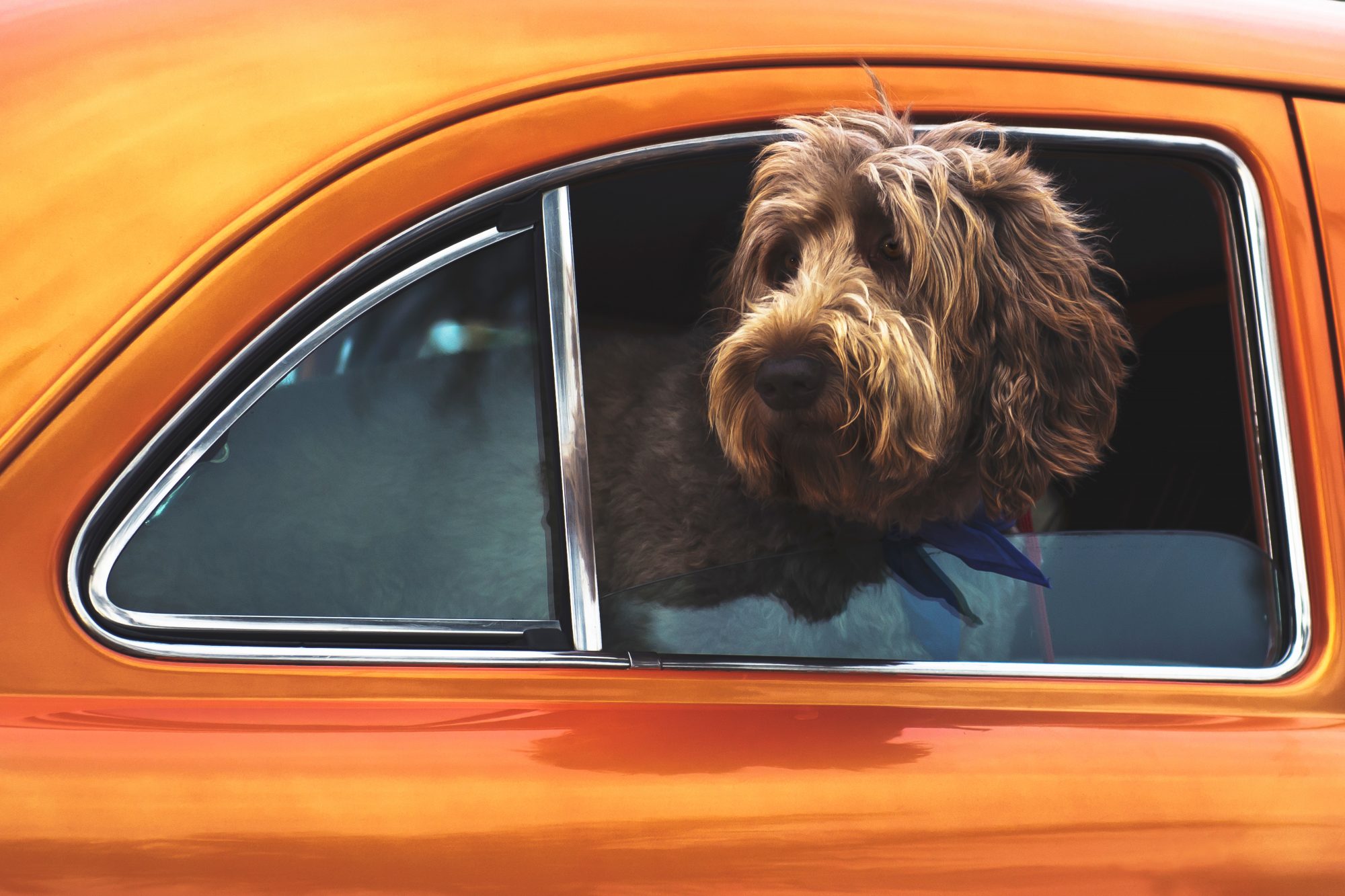
They can happen at any age. We’ve surgically treated a 3 week old pup and a 23 year old kitty.
Virtually any bone in the body can sustain a fracture: skull, vertebrae, legs, pelvis, tail, ribs… no bone is spared!
Just in the past 3 weeks, we’ve had:
. 3 dogs who jumped out of the car window
. 1 dog who jumped off the couch
. 1 dog who was attacked by another one.
. 1 dog who was hit by a car.
And that’s just in 3 weeks!
This blog was written to:
. inform you about how fractures happen.
. tell you how they are commonly repaired.
. help you prevent them.
How do bone fractures happen?
Here are the top 10 reasons (in no particular order):
Falls
Cancer
Gunshot
Hit by car
Fights/Bites
Malformation
Jaw – Bad teeth
Bone deterioration
Fatigue (repeated trauma)
Various traumas (slipping on ice…)
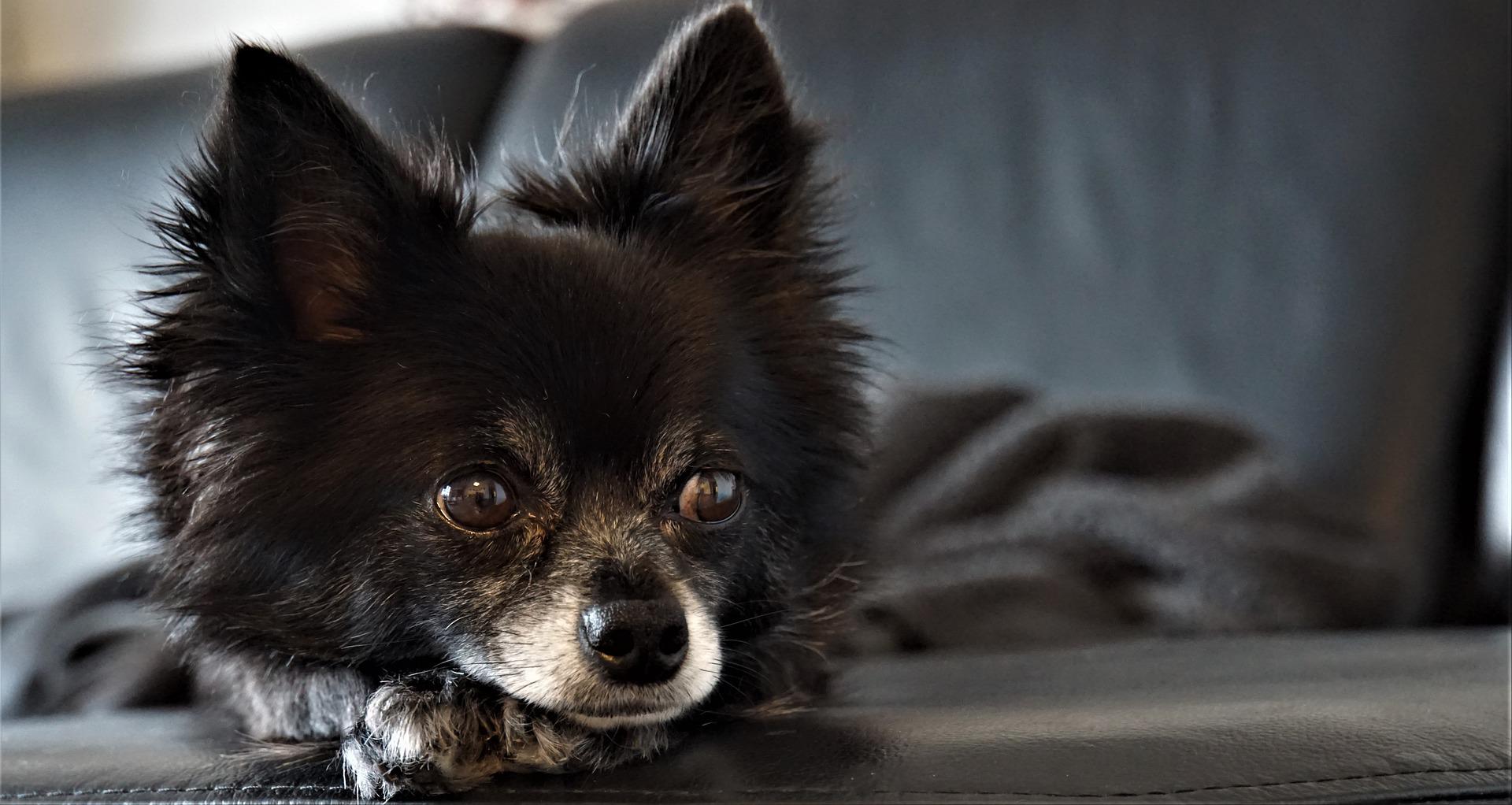
How do we repair bone fractures?
There are multiple types of fractures and multiple ways to repair them. Let’s go over the most common ways.
But wait, not all fractures need surgery.
Some will simply heal with rest, time and pain medication.
Occasionally, healing can be attempted with a splint – a type of bandage reinforced with a molded piece of plastic (I am not too fond of casts…).
The challenge is to know which fractures can predictably heal with a splint.
For example, fractures of the forearm (radius & ulna) and shin bone (tibia & fibula) in small dogs don’t heal well with a splint, and most need surgery. This is a common misconception.
Many fractures require surgery.
There are 2 main ways to fix a fracture:
. with internal fixation, where no implant can be seen outside the skin.
. with external fixation, meaning that the implants are visible from the outside. This is called an external fixator.
- Plates and screws
The most common type of repair involves a bone plate and some screws. A plate is a flat stainless steel bar with holes, designed to keep the pieces of bone together while the fracture heals. The plate is attached to the bone with stainless steel screws.
Plates have different shapes, thicknesses, widths and lengths. The number of screw holes varies accordingly.
So a Yorkie with a forearm (radius) fracture may need a small 6-hole plate, and a Lab with a complicated thigh bone (femur) fracture may need a big 12-hole plate.
Therefore, a surgery practice must stock a variety of plates, since we need to be prepared to help a kitten as well as a Great Dane.
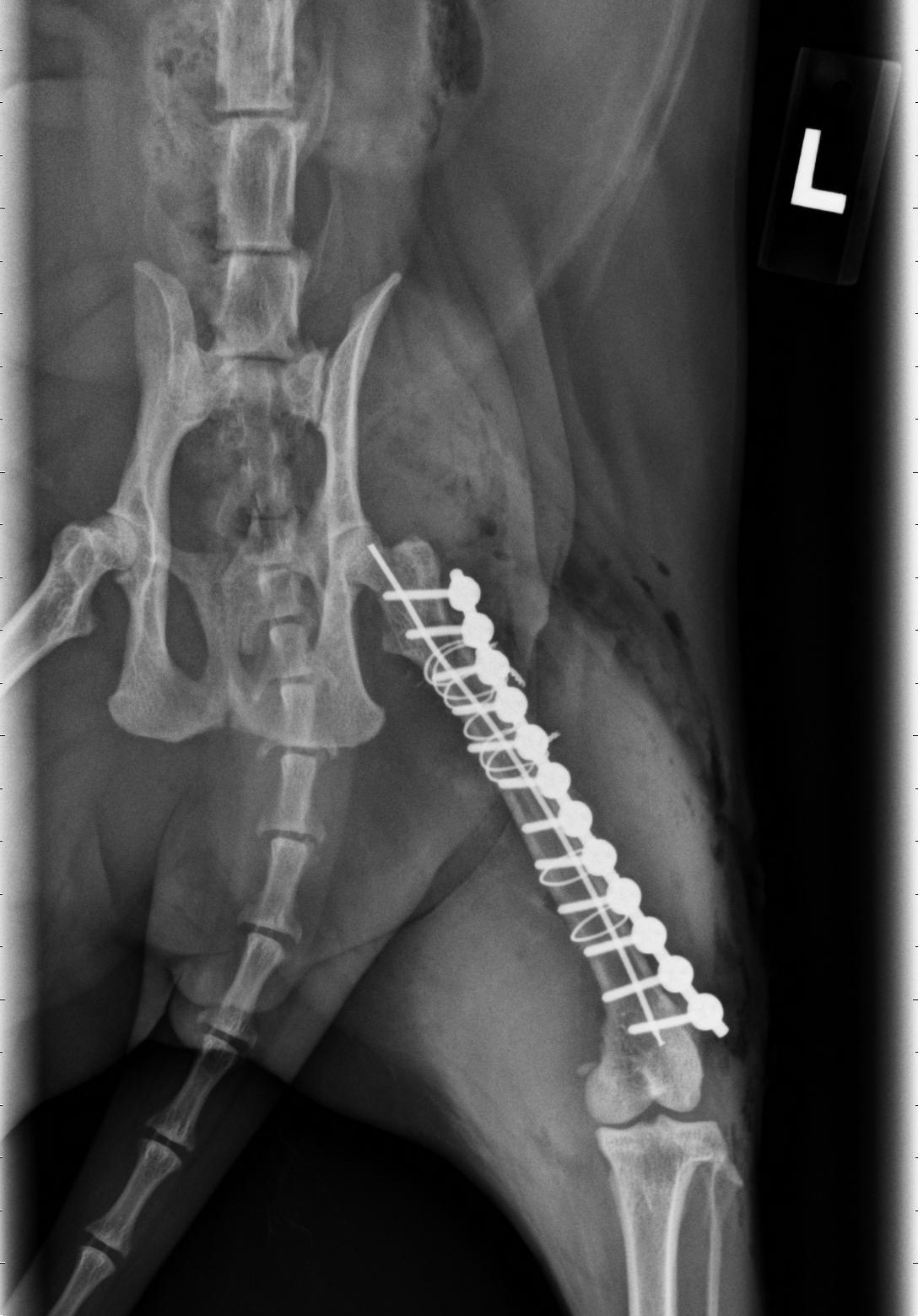
- Wires
To help reconstruct a bone that is in several pieces, we sometimes need the help of stainless steel wire (“cerclage wire”).
Some wire is placed around pieces of bone, and the ends are twisted, like a twisty-tie on your bread.
- Pins
Pins look like knitting needles. They come in various lengths and sizes.
They are used to connect one piece of bone to another. Pins are used in very specific cases, either to reinforce a plate and screw repair (see above), or as the main repair (see below).
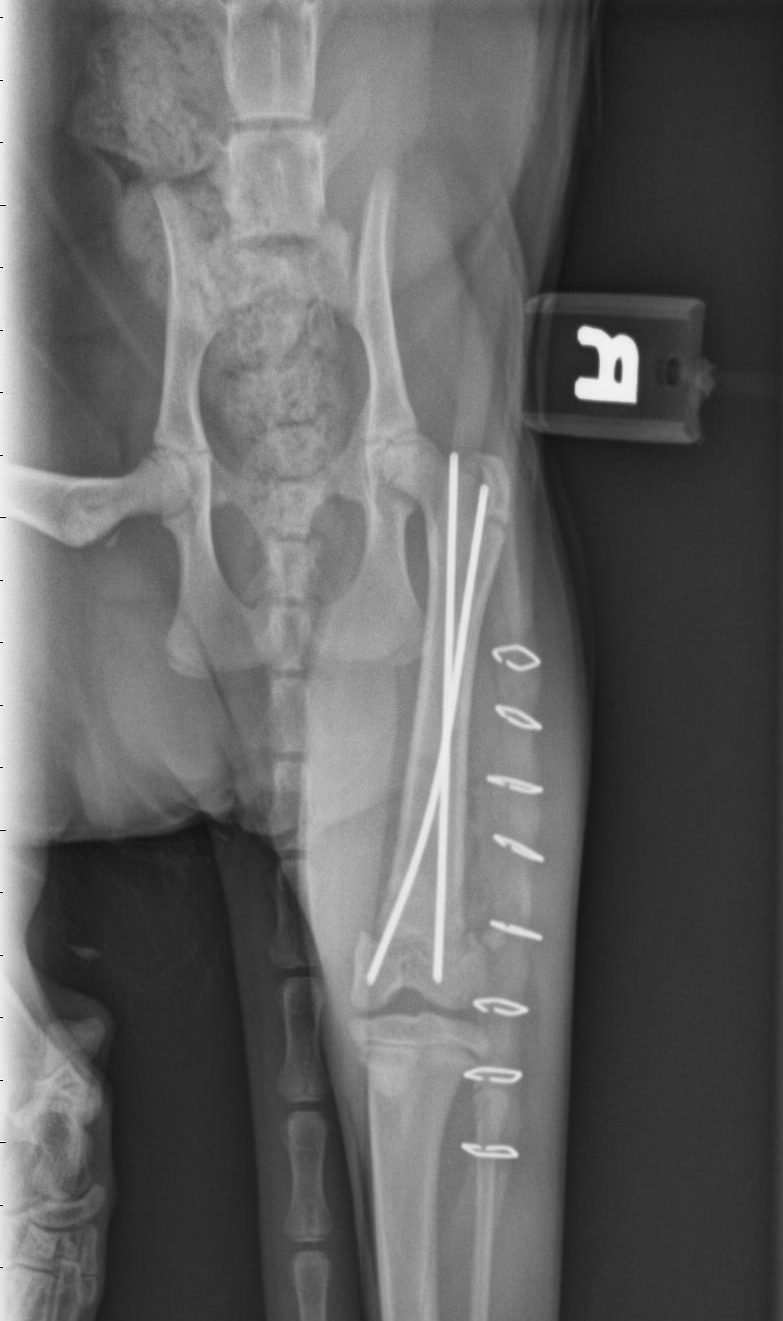
Again, all the implants described above are used under the skin, so they are used for “internal fixation.” Once the surgeon is done, the skin is sutured, and you can’t see anything stick out. These implants are typically designed to stay in forever. Only if they cause problem would we remove them.
- External fixators
In some cases, such as bad gunshot wounds, we prefer using “external fixation.”
There are different types of external fixators, but here is the concept: several pins are placed through the skin, into the broken pieces of bone.
Then a big metal bar, or some other device, is used to connect all the pins. By keeping the pins together, we indirectly keep the pieces of bone aligned, which helps them heal.
To avoid infection, the holes in the skin must be cleaned regularly, e.g. with hydrogen peroxide.
Because it is external to the skin, the fixator must be removed after the fracture is healed. This is typically a quick procedure under heavy sedation or brief anesthesia.
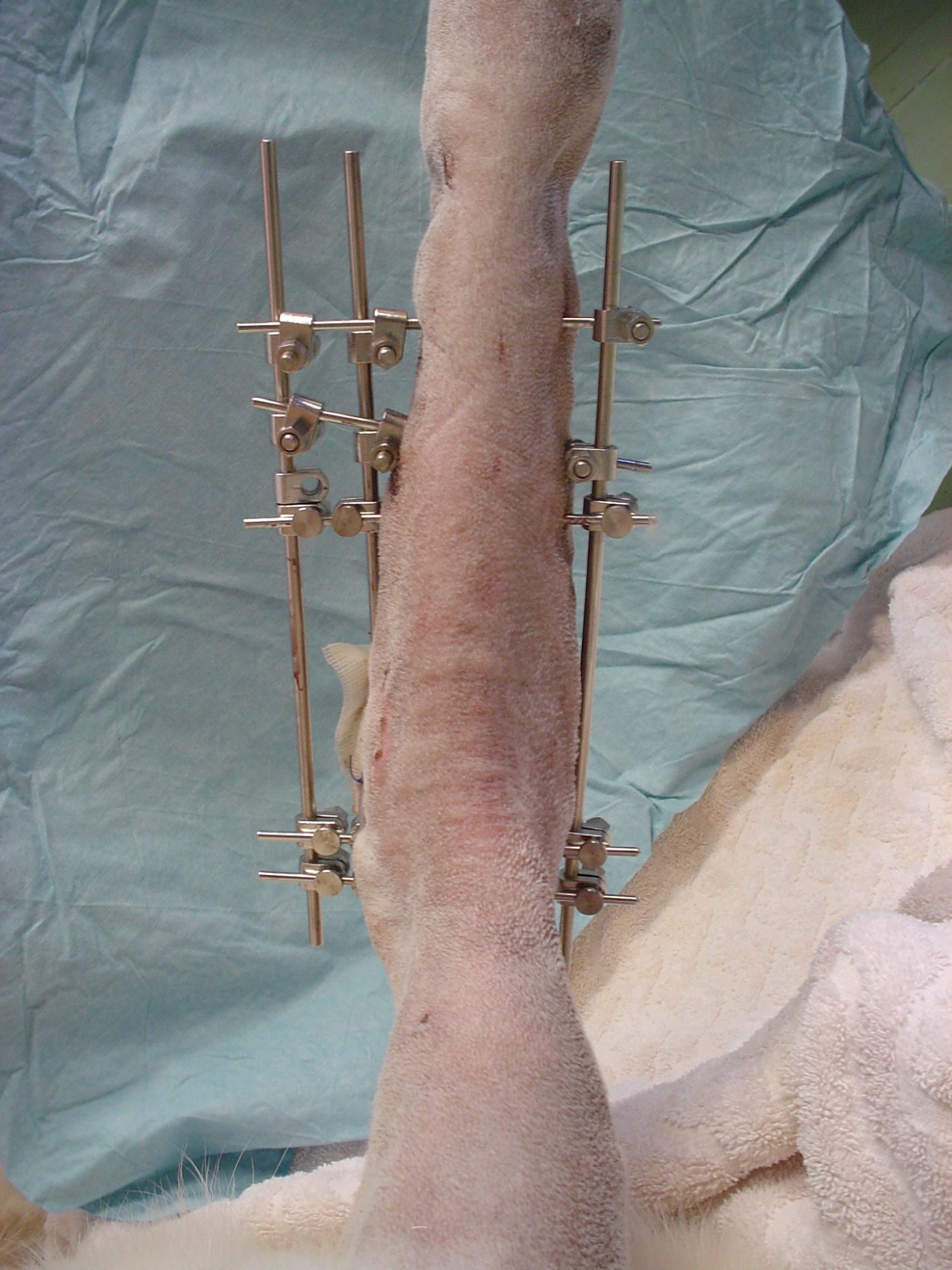
How can you prevent bone fractures?
As always, prevention is the best medicine. Not every fracture can be prevented. Accidents do happen.
Some dogs sustain a fracture while playing in the back yard. Some cats get a fracture while playing indoors. As sad as it is, that is nobody’s fault and simply cannot be avoided.
Many could have been prevented. Several easy ways come to mind:
– Keep your dog on a leash when outdoors to decrease the risk of getting into a fight or being hit by a car.
– Keep cats indoors.
– Keep dogs inside a fenced-in yard.
– Don’t let small dogs jump from your arms or furniture. They can get very common fractures of the forearm or the elbow.
– Never let your car windows open to allow your dog to enjoy the wind and the smells. Remember, we saw 3 dogs who jumped from a car window in the past 3 weeks. All 3 owners swore that they had done it multiple times and they had never jumped before. Which is true… until they did.
Fractures can be painful both to the patient and the owner’s finances. Luckily, most fractures can be repaired and most pets can ultimately lead a normal, happy, comfortable life.
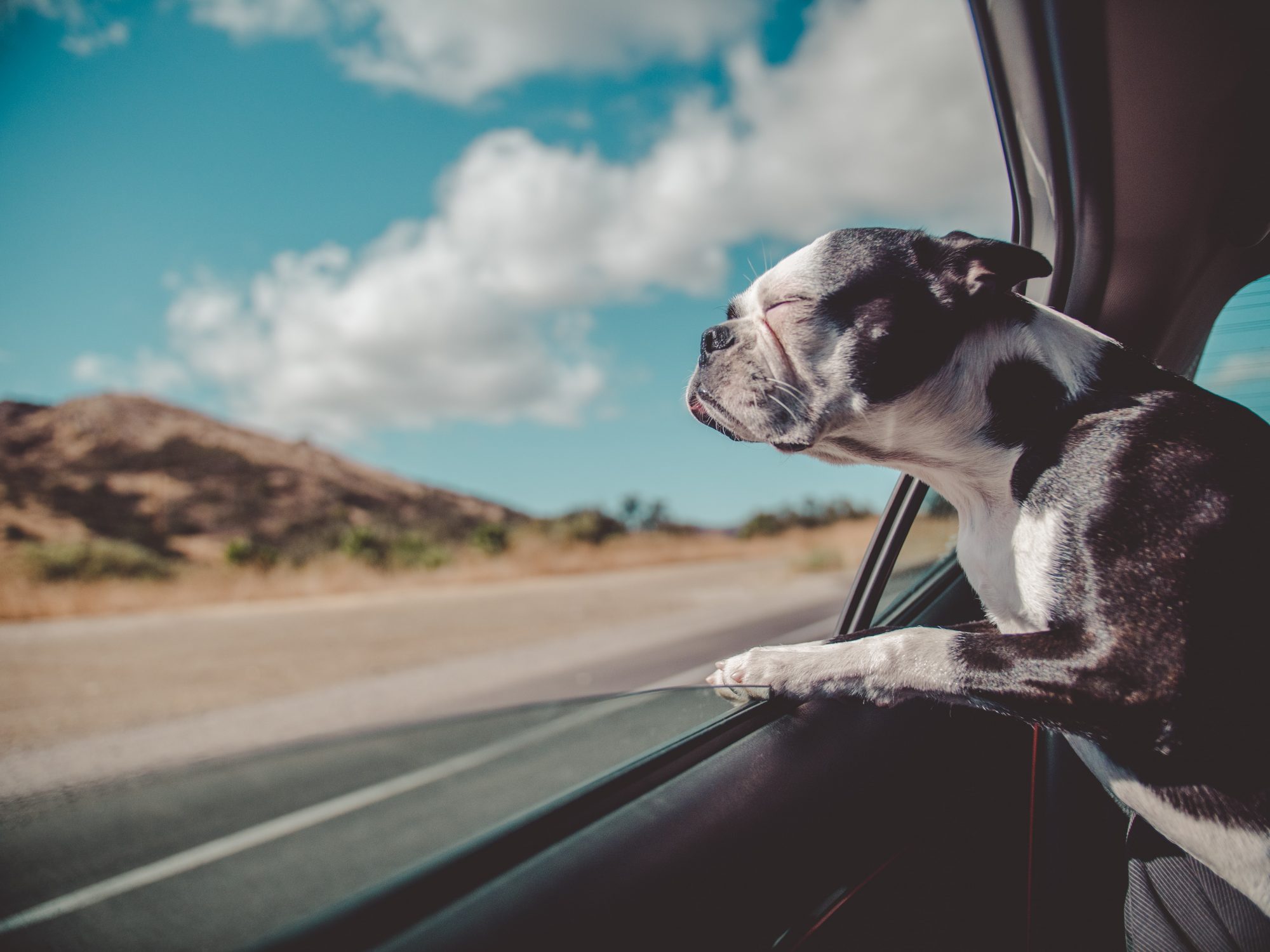
Postop care:
Depending on the fracture, the type of repair and the pet, you might need:
. very strict confinement, on ground zero, in a large crate or a small room, most often for 2 months.
. weekly splint changes if needed.
. regular X-rays to assess healing of the bone.
. pain medications and antibiotics.
. short leash walks for elimination only (for dogs).
. rehab once the bone has healed, to transition to normal life.
Then they can go back to their interrupted agenda: the squirrel herder, the keeper of the couch, the bird chaser, the flower bed destroyer or the overall ruler of the back yard.
Phil Zeltzman, DVM, DACVS, CVJ, Fear Free Certified

Dr. Phil Zeltzman is a traveling veterinary surgeon in Pennsylvania & New Jersey. An award-winning author, he loves to share his adventures in practice along with information about vet medicine and surgery that can really help your pets. Dr. Zeltzman specializes in orthopedic, neurologic, cancer, and soft tissue surgeries for dogs, cats, and small exotics. By working with local family vets, he offers the best surgical care, safest anesthesia, and utmost pain management to all his patients. Sign up to get an email when he updates his blog, and follow him on Facebook, too!
Ninja, my biggest surgical & ethical challenge in 2021
“I beg you for help.”
Such was the subject line of the email.
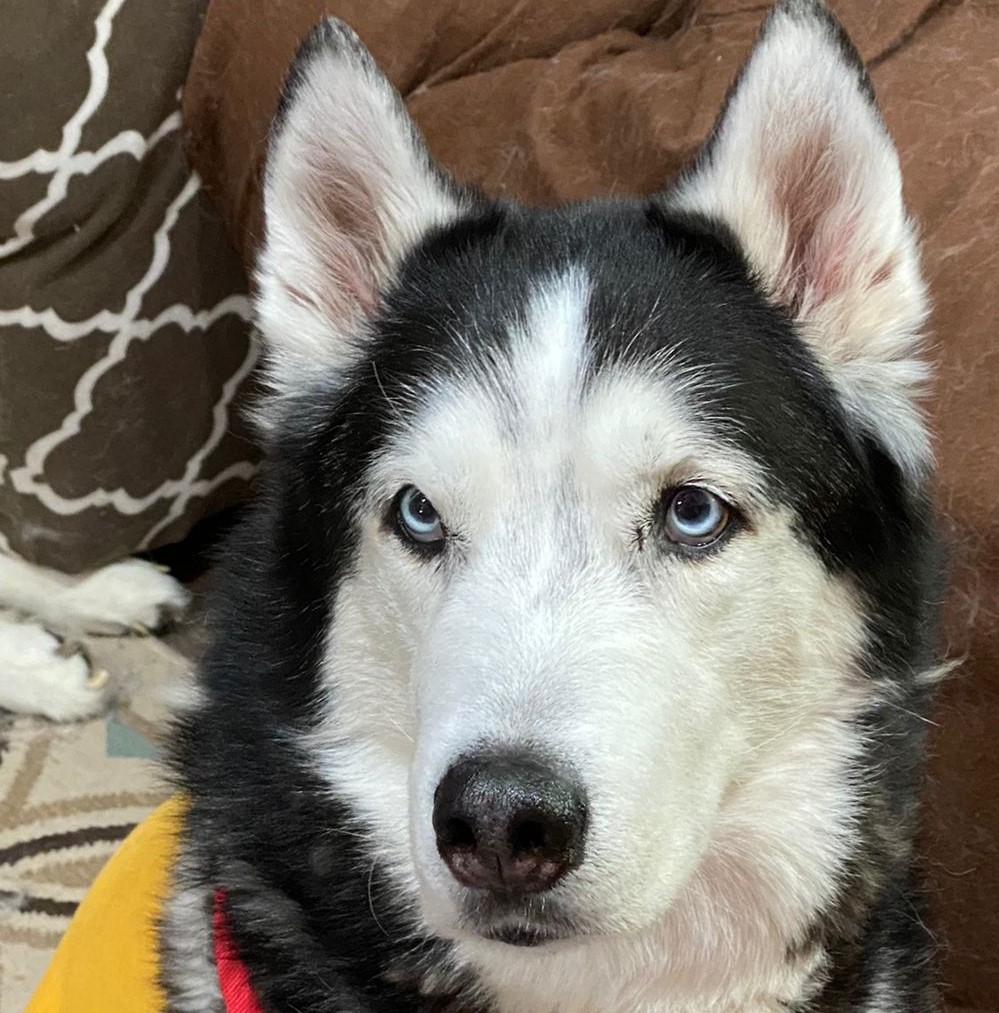
In the email, a pet owner explained:
“My dog Ninja, a 6 year old Siberian Husky, just had a CAT scan, then surgery to drain a cyst in his enlarged prostate” (17 cm long – about 7 inches).
“Because of the pressure on the colon and the bladder, Ninja couldn’t defecate or urinate!”
“His bladder has been so over-stretched, that it couldn’t contract and now Ninja still can’t urinate. A urinary catheter was placed temporarily… and the only option the surgeon gave us was euthanasia!”
“I don’t want to put him down. He is eating, drinking and (now) pooping. He acts normal but can’t pee. Please help me, I am very desperate.”
Desperate times call for desperate measures.
Ninja had a condition similar to unfortunate older gentlemen who struggle to pee because of an enlarged prostate. It is a frustrating & painful situation. But in a dog, it can be life-threatening.
There is a better solution than euthanasia. I suggested a surgery that involves placing a special tube in the bladder and allows draining the bladder on demand.
It’s certainly not for every pet owner, but Ninja’s owners were exactly the right people for the challenge: dedicated, attentive, and totally in tune with their dog. They had done their homework and found out about this option by reading my blog about Madeline, who had the same surgery for a different problem (a bladder tumor).
Chapter 1
Time was of the essence, so we quickly scheduled surgery at Brodheadvsille Vet Clinic.
Ninja had a “cystostomy” surgery, where a tube was placed to drain the bladder through an opening in the skin.
In addition, Ninja was neutered. After that necessary step, male hormones would decrease and cause the prostate to shrink. That would reduce the pressure on the urethra and allow Ninja to urinate.
Chapter 2
Everything went according to plan for about a month… until Ninja accidentally stepped on the tube.
The logical next step was to replace the life-saving drain. Unfortunately, preop bloodwork showed some concerning changes. Ninja’s immune system was attacking his own red blood cells (hemolytic anemia) and platelets (thrombocytopenia). This double condition is called Evans’ syndrome.
So we changed plans. Since it was too risky to perform surgery with such low numbers of red blood cells and platelets, we placed a traditional urinary catheter to allow Ninja to urinate.
We were able to do this thanks to the generosity of another practice owner near Allentown, PA.
The catheter had to be changed frequently to lower the risk of bladder infection (UTI).
His faithful owners would drain the bladder multiple times a day to allow it to stay small. Remember, the bladder was so over-stretched, that it couldn’t contract anymore…
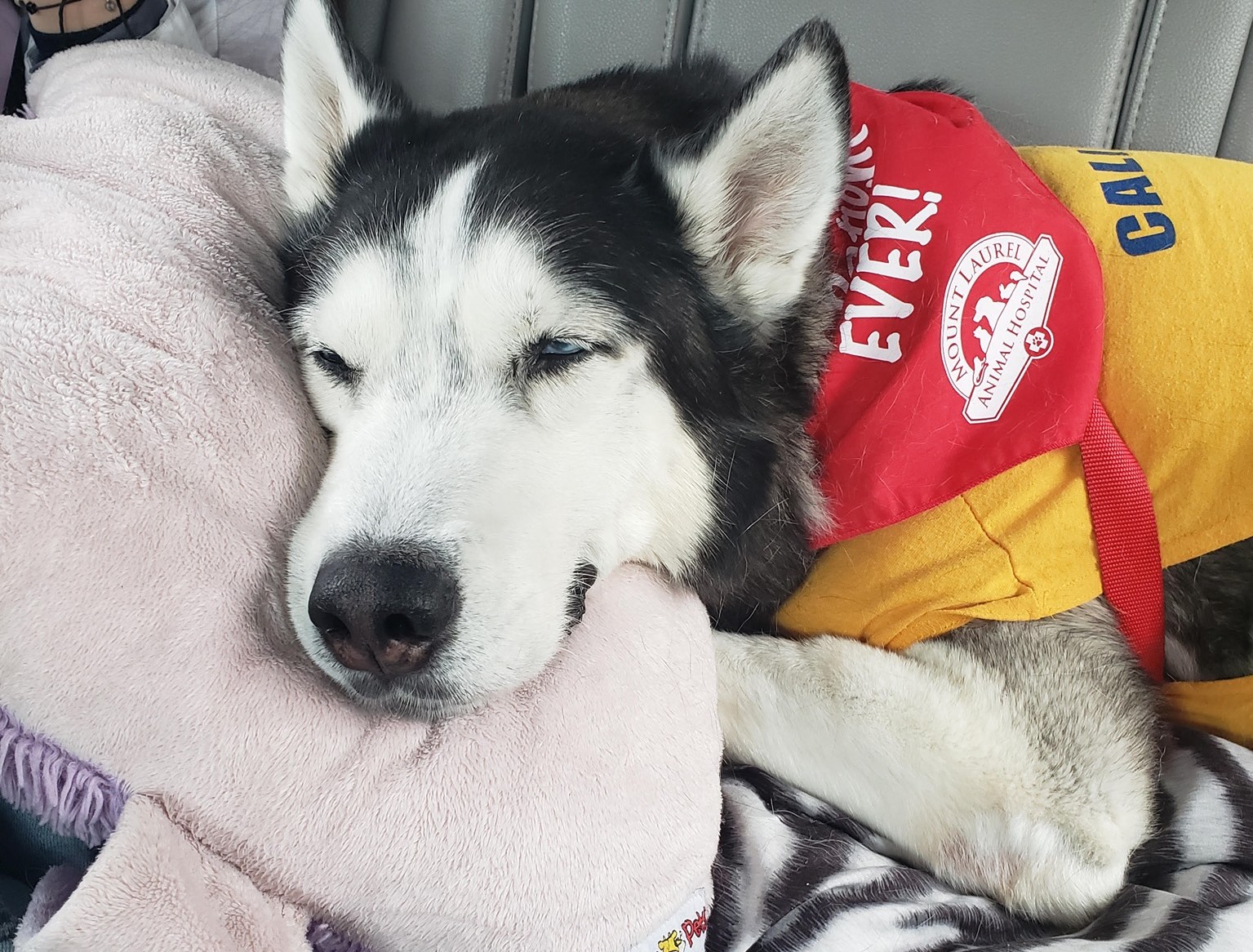
Chapter 3
At that point, Ninja was referred to a board-certified internist (a medicine specialist) to manage his Evans syndrome.
Meanwhile, Ninja still couldn’t pee!
To make matters worse, an ultrasound showed that the prostate now had an abscess. Again, euthanasia was recommended.
Again, his owner called me to see if there were any other options.
After reaching out to multiple specialists, we found one willing to help. My amazing nurse and I suggested a completely crazy plan:
. An ICU specialist at a specialty hospital in NJ accepted to let us use the key to our problem: a special transfusion with platelets to help with clotting.
. We would drain the abscess at another practice in NJ, and place a new cystostomy tube to allow Ninja to pee.
. We would recover Ninja under the supervision the ICU specialist.
Amazingly, Ninja’s owners decided to go with surgery, about 2 months after the first one.
The procedure was uneventful, and after 2 days in ICU, Ninja went home.
Then came weeks and months of amazing dedication from Ninja’s owners.
Long story short, Ninja progressively got better and stronger.
Then out of the blue, to everybody’s surprise, he started to pee on his own!
After agonizing over the right time to remove the tube, we eventually did, once we were convinced that Ninja was emptying his bladder on his own sufficiently to survive.
Now you understand why Ninja was such a technical and mostly ethical dilemma for me.
When should a surgeon stop helping?
When should a pet owner stop hoping?
When should a pet to cross the rainbow bridge?
Why did I choose Ninja’s story…
… over so many other amazing pet stories I was fortunate to play a part in in 2021?
Because of the number of people who played a role in Ninja’s survival.
In the middle of the COVID crisis, it was an absolutely astonishing display of generosity, love and care, by multiple vets and nurses.
Across half a dozen practices.
And across 2 States (PA & NJ).
(trust me, I gave you the short version!!!)
Everybody rallied behind Ninja, led by his loving owners.
And the result is one happy, playful, fluffy Husky, whose only wish is to be comfortable, to be able to pee, and to return his owners’ love.
Ninja’s owner created an amazing video summary.
It’s a story about the love of a family pet.
A story about the power of dedication.
A story about not taking no for an answer.
You can watch it here: https://vm.tiktok.com/ZMRatj6Co/
Fair warning: it’s a tiny bit emotional…
What’s the moral of the story?
1. Neutering early in life decreases or eliminates the chances of having prostate issues in male dogs. There are many other good reasons, which you can read about here:
/blog/top-10-reasons-to-neuter-your-pet/
2. You are your pet’s best advocate. If something makes no sense to you, don’t give up. Sadly, there is not a solution or a cure for every condition. But at least, you should explore your options.
Don’t take no for an answer. Get a second opinion.
This is exactly what Madeline’s and Ninja’s owners did. They didn’t take no for an answer, and they saved their dogs’ lives.
Phil Zeltzman, DVM, DACVS, CVJ, Fear Free Certified

Dr. Phil Zeltzman is a traveling veterinary surgeon in Pennsylvania & New Jersey. An award-winning author, he loves to share his adventures in practice along with information about vet medicine and surgery that can really help your pets. Dr. Zeltzman specializes in orthopedic, neurologic, cancer, and soft tissue surgeries for dogs, cats, and small exotics. By working with local family vets, he offers the best surgical care, safest anesthesia, and utmost pain management to all his patients. Sign up to get an email when he updates his blog, and follow him on Facebook, too!
From Florida to Pennsylvania: Mae Mae the Lab gets “a new lease on life” after tie back surgery for laryngeal paralysis
This may be one of my craziest success stories ever, and definitely my furthest traveling patient ever.
Mae Mae, a 10 year old Lab who had laryngeal paralysis (which we call “lar par”), was traveling from Florida to NY State with her owner.
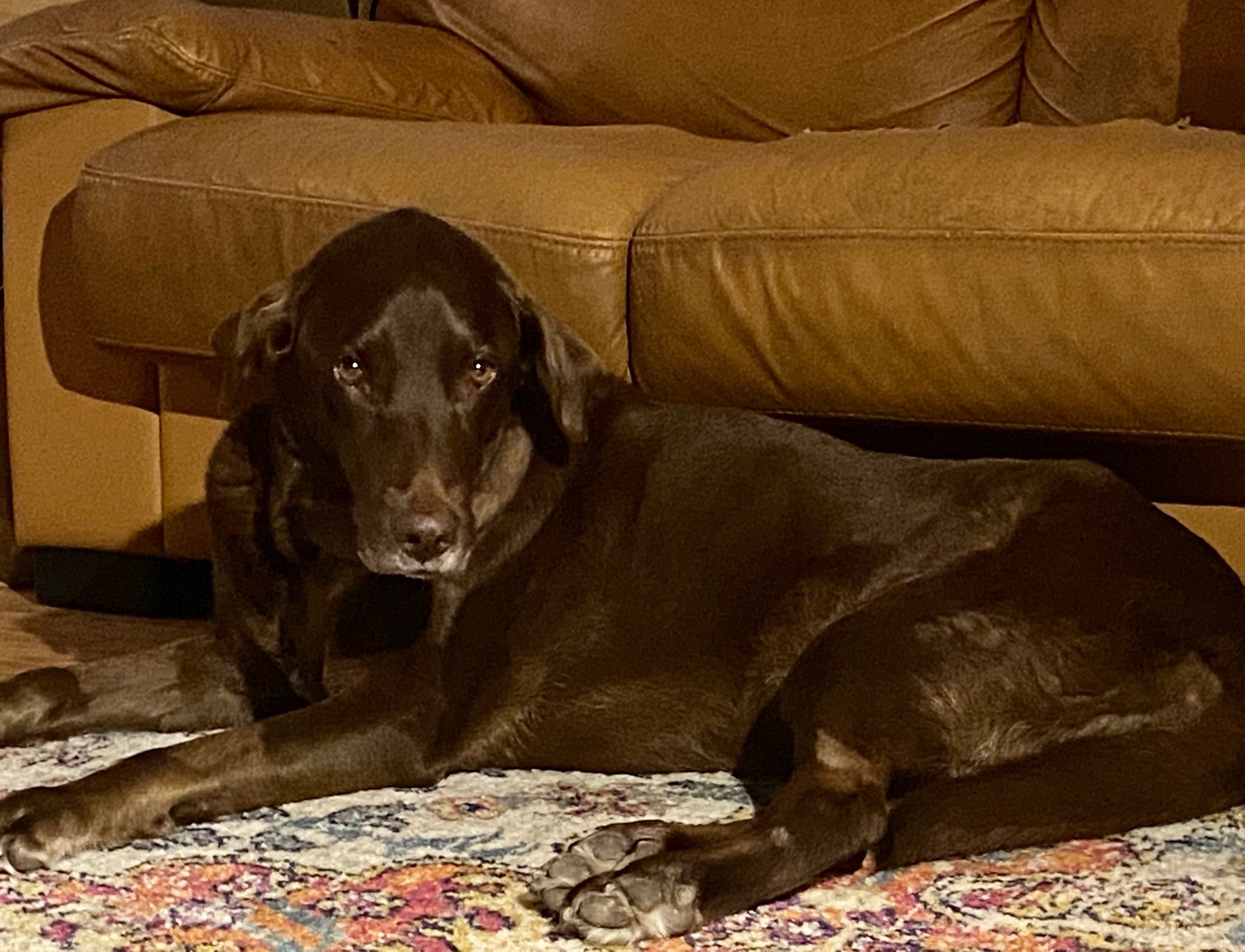
As they arrived in Pennsylvania (where I live), Mae Mae had a severe bout of suffocation. Her owner contacted me after finding me on my website. His dog was in serious trouble.
In his own words: “We were on our way from Key West (FL) to The Adirondacks (NY). As we were driving through Harrisburg, PA, around 11 pm, Mae suddenly couldn’t breathe. Her lar par had, in an instant, gone from manageable to life threatening. Fortunately, we were close to a vet ER. They saved her life. They said she was very healthy and a good candidate for lar par surgery.”
“I sent you an email and was blown away to receive an almost immediate response and then a call. I knew then that Mae Mae was meant to be there in Pennsylvania at that moment and she was meant to live.”
We scheduled Mae Mae for emergency surgery at www.BrodheadsvilleVet.com. Surgery went well. She then recovered well with her owner.
“Great night sleep, for both of us. She’s doing well.”
But then it occurred. The dreaded complication happened: aspiration pneumonia. This is a type of pneumonia due to aspiration, or inhalation, of food, water, saliva or vomit into the lungs. Mae Mae was coughing and was extremely weak. She had no appetite.
She went to the local ER (www.BartonHeights.com).
“She spent a week in the ER. She had been through so much. She had literally given up. Because of COVID, I wasn’t allowed to see her. She was finally allowed in a private room where I spent half the day with her, every day. I would lay on the floor with her for 5 hours a day and try to get her to eat a little. Every day, she made a little more progress.”
It’s true. It looked as if Mae Mae had given up. She wasn’t fighting. So we fought for her. The doctor team and the nursing team did everything by the book to treat the pneumonia: antibiotics, nebulization, antibiotics, coupage, and lots of TLC.
Her biggest cheerleader was her owner. Despite the financial commitment and the emotional rollercoaster, he stood by her side, literally, as much as possible. In the end, Mae Mae recovered and finally continue her trip to the Adirondacks.
Her owner and I are convinced that she recovered thanks to the amazing dedication of one particular nurse, which we will call Shelly.
“Mae Mae is a special soul. You (Dr Zeltzman) and Shelly provided the best medical care I have ever experienced for pet or human. I will never be able to thank you enough.
Thank you for giving Mae Mae a new lease on life. Literally it has been like watching her be reborn. She is 10 years old and I am grateful I will get the opportunity to watch this precious soul grow old.”
Then Mae Mae travelled back home in Florida.
After 1 month, she was doing well, but was still pretty weak.
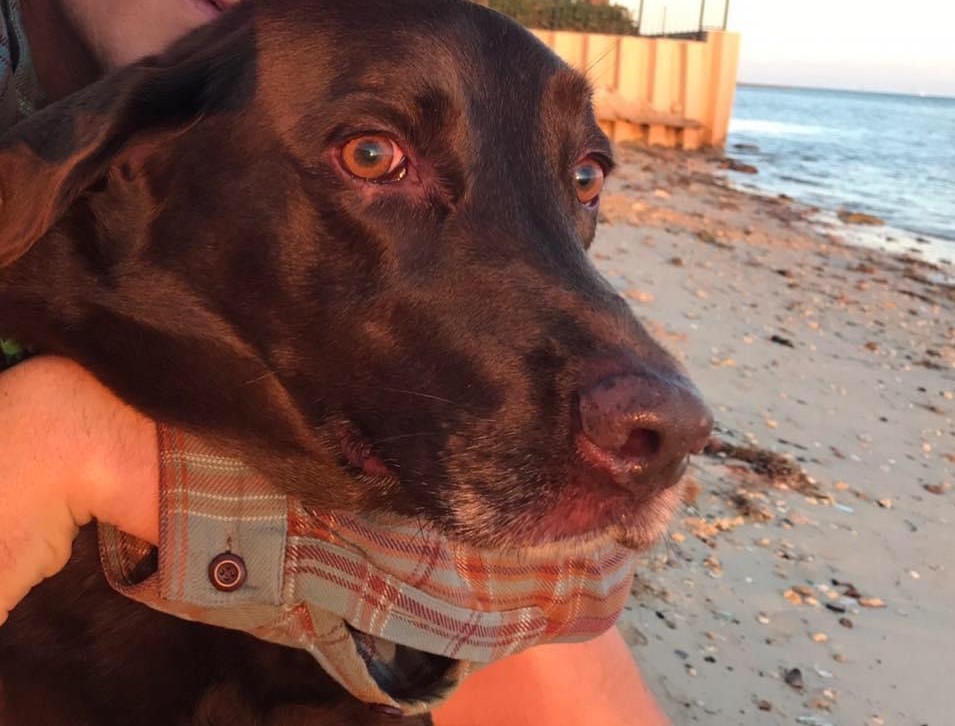
After 2 months, she is happy and much stronger, as shown in this short video: https://youtu.be/67WiKl9tpr4
Bottom line: “lar par is not a death sentence.” It’s a treatable condition. It has definite, well-known, possible complications. Even if we end up with aspiration pneumonia, most dogs who are treated aggressively can overcome this aggressive and potentially deadly complication.
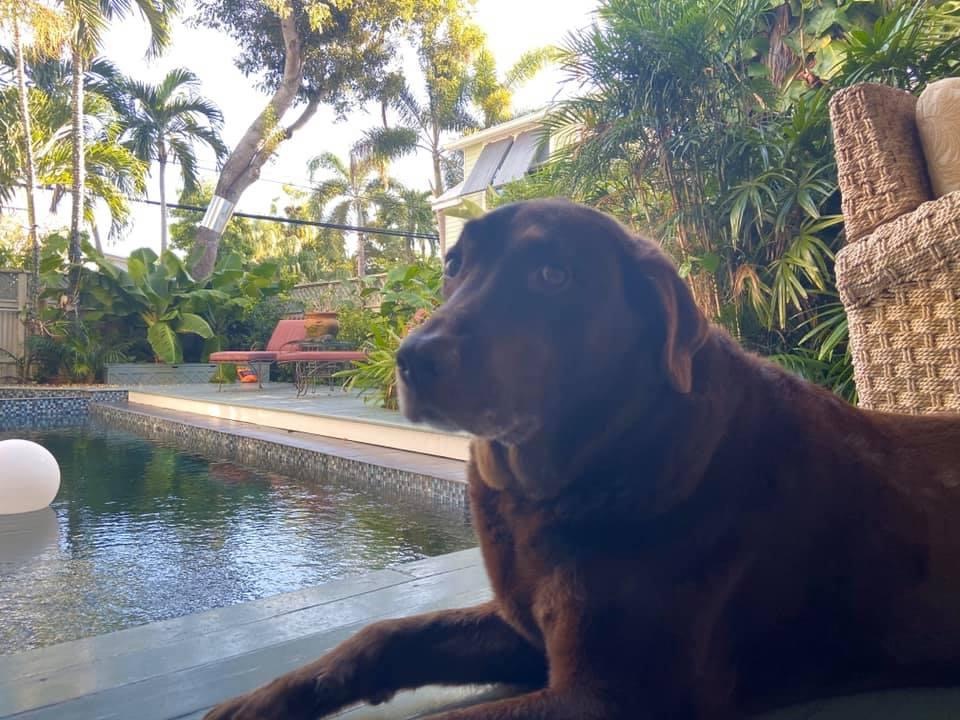
Thanks to her owner’s amazing dedication, Mae Mae can breathe easy in Key West, where she enjoys a life of rest, walks on the beach, good food and puppy love.
Phil Zeltzman, DVM, DACVS, CVJ, Fear Free Certified

Dr. Phil Zeltzman is a traveling veterinary surgeon in Pennsylvania & New Jersey. An award-winning author, he loves to share his adventures in practice along with information about vet medicine and surgery that can really help your pets. Dr. Zeltzman specializes in orthopedic, neurologic, cancer, and soft tissue surgeries for dogs, cats, and small exotics. By working with local family vets, he offers the best surgical care, safest anesthesia, and utmost pain management to all his patients. Sign up to get an email when he updates his blog, and follow him on Facebook, too!
What causes bloat?
“Bloat” is also called many different things: twisted stomach, Gastric Dilatation Volvulus (GDV), gastric torsion, stomach torsion etc.

Side note: it’s unfortunate that we (vets and dog owners) have gotten used to calling it bloat. After all, bloating is not a big deal in people. Yet “bloat” can kill a dog in a matter of hours.

Vets sometimes tell pet owners that we don’t really know what causes GDV, and therefore we don’t know how to prevent it. However, that is not exactly accurate…
Here is a summary of the main known causes.
1. Breed
Large and giant dog breeds are at risk for GDV, including Great Danes (the #1 breed), German shepherds, Weimaraners, St. Bernards, Dobemans and Old English sheepdogs. These breeds are roughly 25% more likely to get GDV than others.
A few smaller breeds, such as basset hounds, boxers, and standard poodles can also be prone to GDV.
2. Conformation
Conformation has to do with the shape of a dog.
Dog breeds called “deep-chested,” have a tall chest and a skinny belly. Think of a Great Dane. A deep chest, combined with stretching of ligaments that attach to the stomach, increases the chance of stomach torsion.
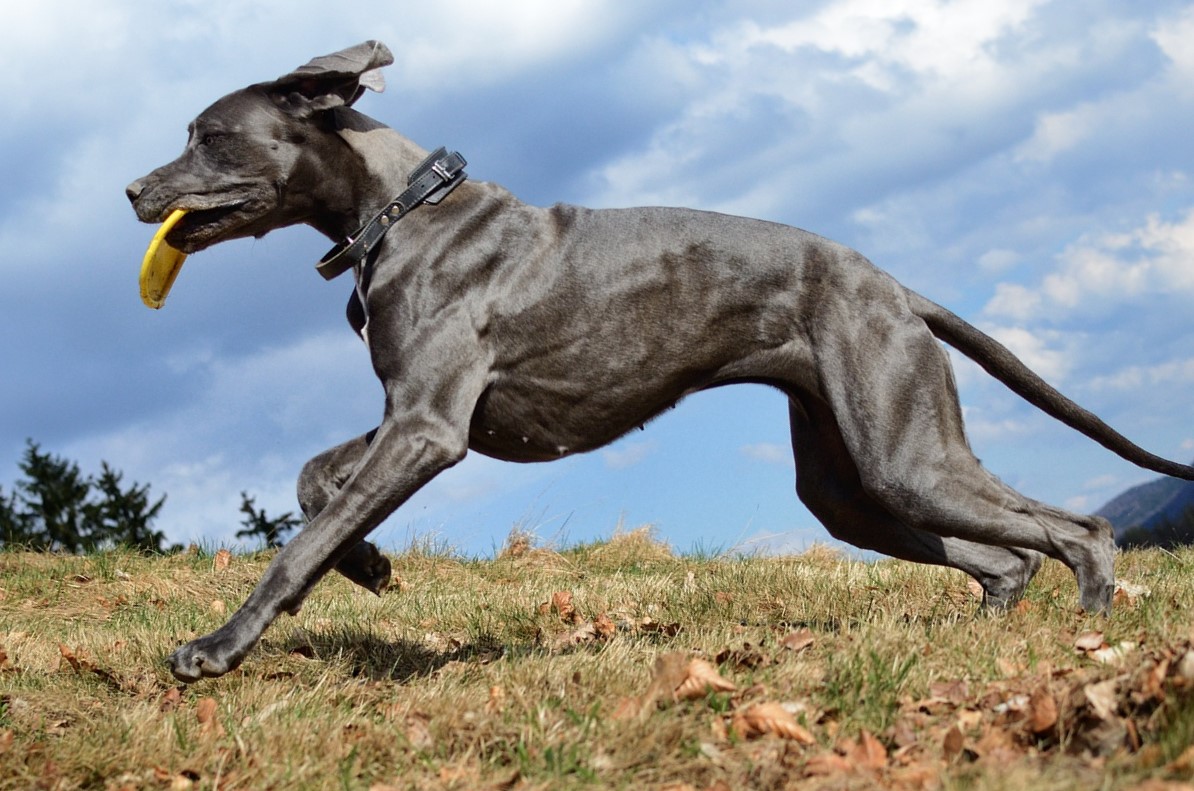
3. Genetics
Dogs with a first-degree relative who had GDV are at greater risk of getting
it themselves. This chance increases by 20% with each additional year. These factors confirm that GDV is a partially genetic disease and dogs at risk should be spayed or neutered.
In addition, better selection should be taken seriously by breeders.
4. Stress
Stressful situations can also contribute to a twisted stomach. Boarding, thunderstorms, moving, vet visits and hospitalization are all potential triggers for nervous dogs.
One study showed that having a high-stress environment or being fearful contributed to GDV compared to similar dogs who were in a non-stressful environment.
5. Feeding
Eating fast, and how often dogs are fed, have been shown to increase the risk of stomach torsion.
Therefore, if your dog eats fast, it’s important to find ways to slow it down. There are special bowls made for that purpose.
In addition, dogs fed once per day are more likely to have GDV, compared to dogs who are fed 3 times daily. Several small meals throughout the day are better for dogs at risk.
6. Food
Believe it or not, studies have shown that moistening dry dog food before feeding actually increases the risk of GDV in large-breed dogs.
Ironically, feeding a dry-only diet has also been shown to increase risk.
So what’s a concerned dog owner to do?
Recommendations have been made to help prevent a first episode by avoiding exclusively dry, expanded, cereal-based, or soy protein-based commercial dog foods.
Feeding a combination of dry and canned food together may be a way to lower the chances of GDV. I insist: “may be a way.” There are no guarantees here, only ways to try to lower the chances.
Also, foods with fat listed among the main 4 ingredients have been shown to increase the risk of GDV. So please look at the list of ingredients on your dog food.
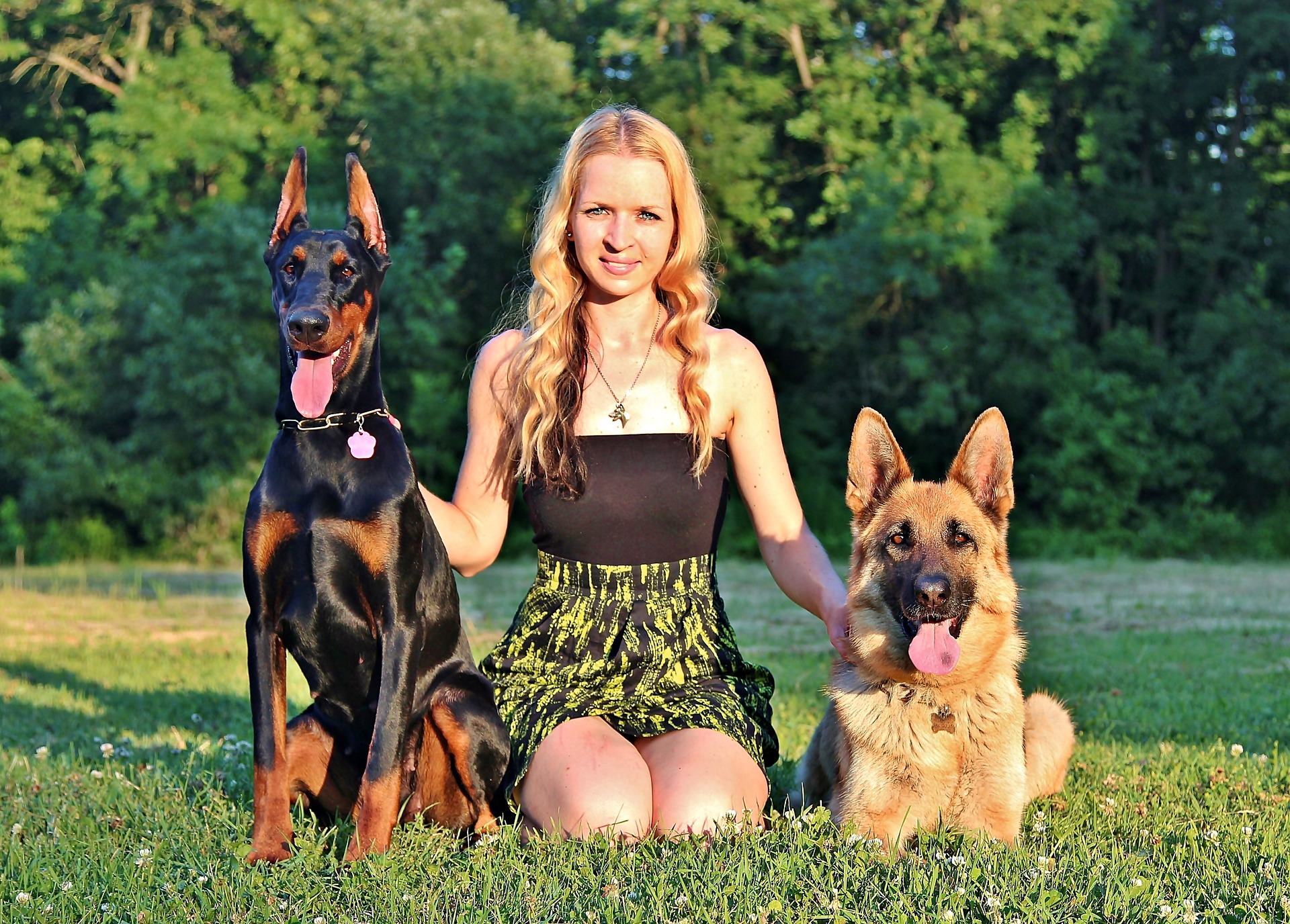
7. Water
It is recommended to avoid drinking large amounts of water before and after exercise.
Ironically, too little water before and during meals may increase the chance of a dog suffering from GDV! A recurring “hot story” about ice water causing GDV regularly shows up online and appears to be a complete hoax.
8. Exercise
A fairly classic recommendation to reduce the risk of stomach torsion is to avoid heavy exercise 1 hour before and 2 hours after eating a meal. The idea is that it’s easier for a stomach to twist when it’s full compared to when it’s (partially) empty.
9. Age
Even though I always say, “age is not a disease,” age can play a role in a dog’s risk for stomach torsion.
In Great Danes specifically, age is a very important risk factor for GDV.
One of the reasons may be the stretched ligaments, over time, as mentioned above.
10. Other risk factors
There are countless other risk factors that are unproven, controversial, or contradicting.
. For example, some studies show that a raised bowl is better to decrease aerophagia (aka swallowing air), while others imply a bowl on the floor is ideal.
. The at-risk gender varies from study to study.
. The month, the cycle of the moon, and a previous spleen removal are also fuzzy risk factors.
- Gastropexy
This last point is not a risk factor – on the opposite, but it’s important to mention here.
A gastropexy, or tacking the stomach to the inside of the belly, is a simple surgery that can prevent twisting of the stomach. In good hands, it’s successful over 95% of the time.
Importantly, it prevents twisting of the stomach, not true “bloating” – aka the stomach getting full of air – we don’t know how to prevent that and it remains a risk for life.

The gastropexy or “pexy” in short is part of the surgery to treat GDV. But it can also be done preventively, or prophylactically. So it’s called a prophylactic gastropexy.
For example, Great Danes have a 40 % chance of having GDV in their lifetime. Ideally, this life-saving surgery should be performed at the time of the dog’s spay or neuter – or as soon as possible after that. Of course, it’s never too late to prophylactically pexy a dog… until they have an episode of GDV.
Please beware, the next picture of a gastropexy can seem graphic to some readers.

I have helped a number of pet owners perform gastropexies over the years. Some were wise to do it before GDV happens in their at-risk dog. Some learned the hard way (i.e. their dog got a twisted stomach, and that’s how they learned about the pexy option).
Either way, it can be done as a “stand alone” surgery, or at the time of a spay or neuter.
To recap, we know a lot about the risk factors of GDV. Be aware of them, and prevent those you can control. You could very well save your dog’s life.
Phil Zeltzman, DVM, DACVS, CVJ, Fear Free Certified

Dr. Phil Zeltzman is a traveling veterinary surgeon in Pennsylvania & New Jersey. An award-winning author, he loves to share his adventures in practice along with information about vet medicine and surgery that can really help your pets. Dr. Zeltzman specializes in orthopedic, neurologic, cancer, and soft tissue surgeries for dogs, cats, and small exotics. By working with local family vets, he offers the best surgical care, safest anesthesia, and utmost pain management to all his patients. Sign up to get an email when he updates his blog, and follow him on Facebook, too!
Should you wait to get help for your pet?
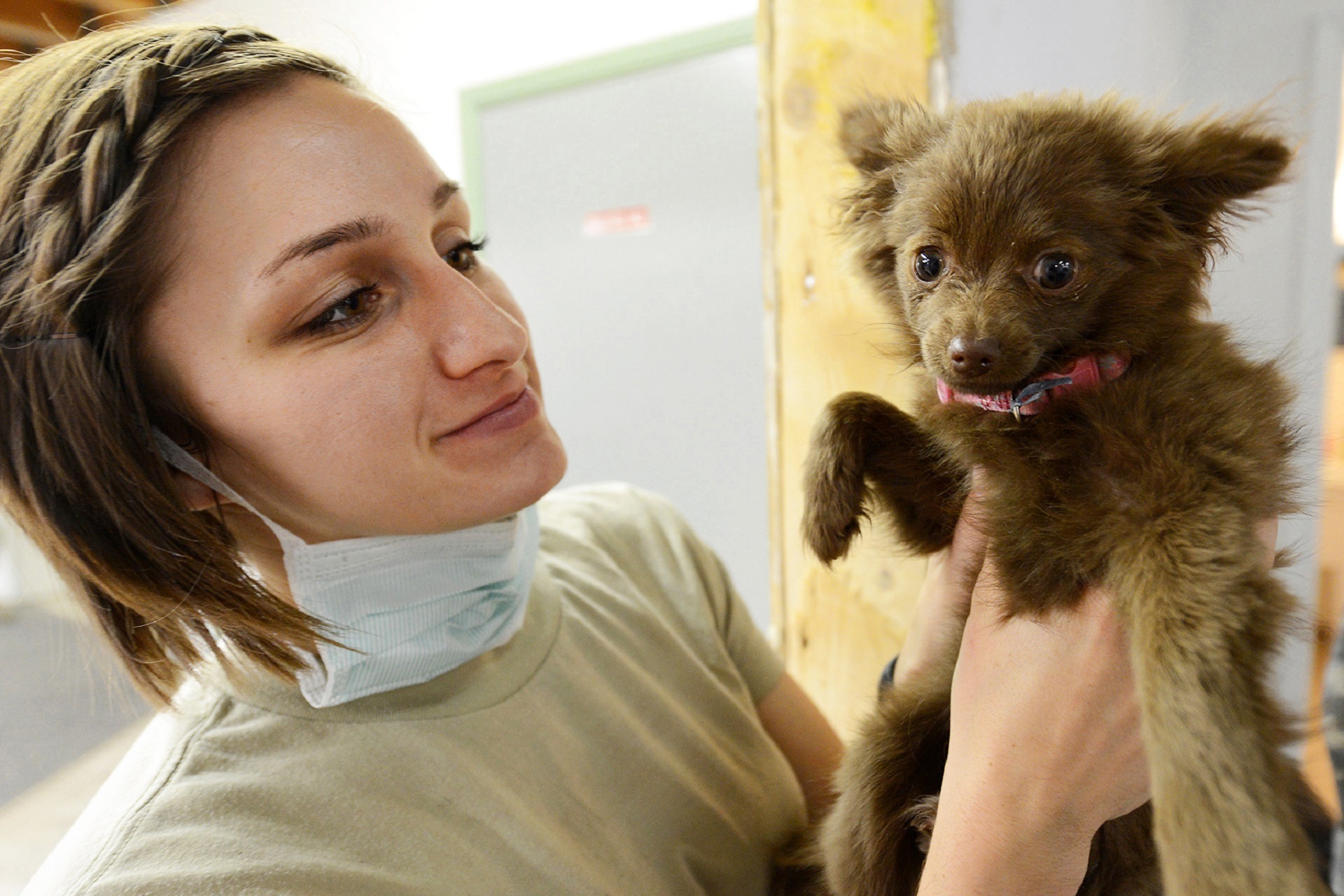
Your pet is vomiting. Should you wait to go to the vet?
Your pet is limping. Should you wait to seek help?
Your pet has a mass. Should you wait to have it looked at?
These are common dilemmas, and the answer is… it depends!
Let’s keep our 3 examples.
. Many pets vomit every once in a while, and they are perfectly healthy otherwise.
Other times, repeated vomiting is a sign that something is brewing inside. And it could be anything: stomach problems, intestinal conditions, kidney disease, cancer etc.
. Some pets limp because of a sprain and get over it by the next day, just like a human.
Other times, ongoing limping is a sign of a problem: elbow arthritis, hip dysplasia or the most common cause of limping: a torn ACL.
. Many pets have skin masses. Most masses can only do one thing: get bigger. Very rarely does a mass get smaller. It would defy science: as cells divide, which they are genetically programmed to do, the mass gets bigger. It can be slow or it can be fast, but they usually get bigger over time. The only way to objectively know what is going on is to measure it.
So what’s a pet lover to do?
Should you keep an eye on it?
For a short while, possibly.
Waiting any longer is rarely a good idea.
. Repeated vomiting can lead to dehydration and electrolytes imbalances.
. An untreated joint problem invariably leads to arthritis, which can only get worse over time.
. A small mass is easier, less invasive and cheaper to remove than a large mass. This translates to longer anesthesia, higher surgery fees and higher chances of complications.
Occasionally, you will be a bit early and it’s a false alarm.
Most times, you will be right and acting early will save you time, money and frustration while avoiding pain for your pet.
At the very least, call your vet to ask questions. Many vets now offer telemedicine consultations, which means you don’t even have to take your pet to the vet. You can get advice from the comfort of your home.
Just keep in mind that vomiting may require X-rays or an ultrasound, limping may require X-rays and a mass may require lab testing.
Either way, don’t procrastinate, it rarely leads to good results.
Phil Zeltzman, DVM, DACVS, CVJ, Fear Free Certified

Dr. Phil Zeltzman is a traveling veterinary surgeon in Pennsylvania & New Jersey. An award-winning author, he loves to share his adventures in practice along with information about vet medicine and surgery that can really help your pets. Dr. Zeltzman specializes in orthopedic, neurologic, cancer, and soft tissue surgeries for dogs, cats, and small exotics. By working with local family vets, he offers the best surgical care, safest anesthesia, and utmost pain management to all his patients. Sign up to get an email when he updates his blog, and follow him on Facebook, too!

